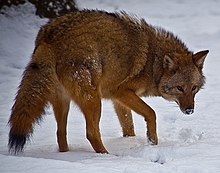
Description
Adult eastern coyotes are larger than western coyotes, weighing an average of 30-40 lbs, with female eastern coyotes weighing 21% more than male western coyotes.[5][9] Eastern coyotes also weigh more at birth; while newborn western coyotes weigh 250-300 grams, eastern coyotes weigh 349-360 grams. By the age of 35 days, eastern coyote pups average 1590 grams, 200 grams more than western coyotes of similar age. By this time, physical differences become more apparent, with eastern coyote pups having longer legs than their western counterparts. Differences in dental development also occur, with tooth eruption being later, and in a different order in the eastern coyote.[10] Aside from its size, the eastern coyote is physically not unlike the western coyote; both have erect ears, a straight and bushy tail, a conspicuous supracaudal gland and a narrow chest. There are four color phases, ranging from dark brown to blond or reddish blond, though the most common phase is gray-brown, with reddish legs, ears and flanks.[11] There are no significant differences between eastern and western coyotes in expressing aggression and fighting, though eastern coyotes tend to fight less, and are more playful. Unlike western coyote pups, in which fighting precedes play behavior, fighting among eastern coyote pups occurs after the onset of play.[10] Eastern coyotes tend to reach sexual maturity when they reach two years of age, much later than in western coyotes.[5]Food

Eastern coyotes predate a variety of prey including mammals as small as a mouse and as large as moose; however, the Ontario Ministry of Natural Resources lists their main prey items as rabbits, hares and deer in the winter and small mammals, wild berries, birds, amphibians and grasshoppers in the summer.[12]
Eastern Coyotes are known as opportunistic omnivores and will prey on whatever is available and easy to scavenge or kill. The diet of the Eastern Coyote will shift and change with the seasons. Their diet can include, but is not limited to, feeding on insects, and berries during summer, to small mammals in the fall and throughout the winter. As winter becomes harder later in the season, larger game, such as the white-tailed deer, becomes a target for the coyote. Coyotes will hunt in pairs in many cases and can bring down a healthy, adult deer, however, deer killed by vehicles or by other natural causes are the more frequent target for the scavenging coyote. Researchers from the State University of New York College of Environmental Science and Forestry examined animal carcasses visited by radio-collared coyotes during the winter and summer of 2008-09. During the winter, only 8% of adult deer had been killed conclusively by coyotes. The remaining 92% were scavenged by coyotes after being killed by vehicles and other injuries. The adult deer that were killed by coyotes had severe preexisting injuries and were likely to die from other causes in the absence of coyote predation. In the spring the target for the coyote will shift to the newborn fawns as they are a much easier target for a coyote.[13][14][15][16]

No comments:
Post a Comment
Note: Only a member of this blog may post a comment.